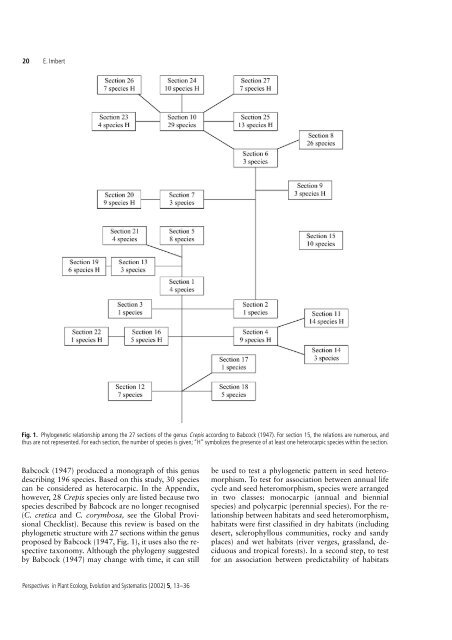Ecological consequences and ontogeny of seed ... - Accueil du site
Ecological consequences and ontogeny of seed ... - Accueil du site
Ecological consequences and ontogeny of seed ... - Accueil du site
Create successful ePaper yourself
Turn your PDF publications into a flip-book with our unique Google optimized e-Paper software.
20 E. Imbert<br />
Fig. 1. Phylogenetic relationship among the 27 sections <strong>of</strong> the genus Crepis according to Babcock (1947). For section 15, the relations are numerous, <strong>and</strong><br />
thus are not represented. For each section, the number <strong>of</strong> species is given; “H” symbolizes the presence <strong>of</strong> at least one heterocarpic species within the section.<br />
Babcock (1947) pro<strong>du</strong>ced a monograph <strong>of</strong> this genus<br />
describing 196 species. Based on this study, 30 species<br />
can be considered as heterocarpic. In the Appendix,<br />
however, 28 Crepis species only are listed because two<br />
species described by Babcock are no longer recognised<br />
(C. cretica <strong>and</strong> C. corymbosa, see the Global Provisional<br />
Checklist). Because this review is based on the<br />
phylogenetic structure with 27 sections within the genus<br />
proposed by Babcock (1947, Fig. 1), it uses also the respective<br />
taxonomy. Although the phylogeny suggested<br />
by Babcock (1947) may change with time, it can still<br />
Perspectives in Plant Ecology, Evolution <strong>and</strong> Systematics (2002) 5, 13–36<br />
be used to test a phylogenetic pattern in <strong>seed</strong> heteromorphism.<br />
To test for association between annual life<br />
cycle <strong>and</strong> <strong>seed</strong> heteromorphism, species were arranged<br />
in two classes: monocarpic (annual <strong>and</strong> biennial<br />
species) <strong>and</strong> polycarpic (perennial species). For the relationship<br />
between habitats <strong>and</strong> <strong>seed</strong> heteromorphism,<br />
habitats were first classified in dry habitats (including<br />
desert, sclerophyllous communities, rocky <strong>and</strong> s<strong>and</strong>y<br />
places) <strong>and</strong> wet habitats (river verges, grassl<strong>and</strong>, deci<strong>du</strong>ous<br />
<strong>and</strong> tropical forests). In a second step, to test<br />
for an association between predictability <strong>of</strong> habitats


